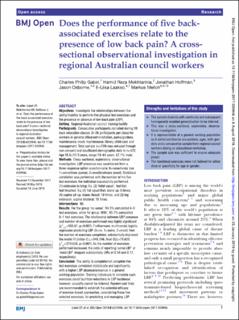Please use this identifier to cite or link to this item:
https://doi.org/10.21256/zhaw-4989Full metadata record
| DC Field | Value | Language |
|---|---|---|
| dc.contributor.author | Gabel, Charles Philip | - |
| dc.contributor.author | Mokhtarinia, Hamid Reza | - |
| dc.contributor.author | Hoffman, Jonathan | - |
| dc.contributor.author | Osborne, Jason | - |
| dc.contributor.author | Laakso, E-Liisa | - |
| dc.contributor.author | Melloh, Markus | - |
| dc.date.accessioned | 2019-01-23T15:38:30Z | - |
| dc.date.available | 2019-01-23T15:38:30Z | - |
| dc.date.issued | 2018 | - |
| dc.identifier.issn | 2044-6055 | de_CH |
| dc.identifier.uri | https://digitalcollection.zhaw.ch/handle/11475/14577 | - |
| dc.description.abstract | Objectives: Investigate the relationships between the ability/inability to perform five physical test exercises and the presence or absence of low back pain (LBP). Setting Regional Australian council training facility. Participants: Consecutive participants recruited during 39 back education classes (8–26 participants per class) for workers in general office/administration, parks/gardens maintenance, roads maintenance, library, child care and management. Total sample (n=539) was reduced through non-consent and insufficient demographic data to n=422. Age 38.6±15.3 years, range 18–64 years, 67.1% male. Methods: Cross-sectional, exploratory, observational investigation. LBP presence was ascertained from a three-response option questionnaire: 0=none/rarely (no) 1=sometimes (some), 2=mostly/always (most). Statistical correlation was performed with the number of the five test exercises the individual successfully performed: (1) extension in lying: 3 s; (2) ‘toilet squat’; feet flat, feet touched: 3 s; (3) full squat then stand up: 5 times; (4) supine sit-up, knees flexed: 10 times; and (5) leg extension, supine bilateral: 10 times. Interventions: Nil. Results: For the group ‘no-some’, 94.3% completed 4–5 test exercises, while for group ‘With’, 95.7% completed 0–1 test exercises. The relationship between LBP presence and number of exercises performed was highly significant (χ2 (10)=300.61, p<0.001). Furthermore, multinomial logistic regression predicting LBP (0=no, 1=some, 2=most) from the number of exercises completed, substantially improved the model fit (initial-2LL=348.246, final-2LL=73.620, χ2 (2)=274.626, p<0.001). As the number of exercises performed increased, the odds of reporting ‘some LBP’ or ‘most LBP’ dropped substantially (ORs of 0.34 and 0.17, respectively). Conclusion: The ability to complete/not complete five test exercises correlated statistically and significantly with a higher LBP absence/presence in a general working population. Training individuals to complete such exercises could facilitate reductions in LBP incidence; however, causality cannot be inferred. Randomised trials are recommended to establish the potential efficacy of exercise-based approaches, considering these five selected exercises, for predicting and managing LBP. | de_CH |
| dc.language.iso | en | de_CH |
| dc.publisher | BMJ Publishing Group | de_CH |
| dc.relation.ispartof | BMJ Open | de_CH |
| dc.rights | http://creativecommons.org/licenses/by-nc/4.0/ | de_CH |
| dc.subject | Functional exercises | de_CH |
| dc.subject | Low back pain | de_CH |
| dc.subject | Preventive medicine | de_CH |
| dc.subject | Rehabilitation medicine | de_CH |
| dc.subject.ddc | 617.5: Orthopädische Chirurgie | de_CH |
| dc.title | Does the performance of five back-associated exercises relate to the presence of low back pain? : a cross-sectional observational investigation in regional Australian council workers | de_CH |
| dc.type | Beitrag in wissenschaftlicher Zeitschrift | de_CH |
| dcterms.type | Text | de_CH |
| zhaw.departement | Gesundheit | de_CH |
| zhaw.organisationalunit | Institut für Public Health (IPH) | de_CH |
| dc.identifier.doi | 10.21256/zhaw-4989 | - |
| dc.identifier.doi | 10.1136/bmjopen-2017-020946 | de_CH |
| dc.identifier.pmid | 30093512 | de_CH |
| zhaw.funding.eu | No | de_CH |
| zhaw.issue | 8 | de_CH |
| zhaw.originated.zhaw | Yes | de_CH |
| zhaw.publication.status | publishedVersion | de_CH |
| zhaw.volume | 8 | de_CH |
| zhaw.publication.review | Peer review (Publikation) | de_CH |
| Appears in collections: | Publikationen Gesundheit | |
Files in This Item:
| File | Description | Size | Format | |
|---|---|---|---|---|
| 2018_Gabel_Does_the_performance_of_five_back_associated_exercises_relate.pdf | 357.06 kB | Adobe PDF |  View/Open |
Show simple item record
Gabel, C. P., Mokhtarinia, H. R., Hoffman, J., Osborne, J., Laakso, E.-L., & Melloh, M. (2018). Does the performance of five back-associated exercises relate to the presence of low back pain? : a cross-sectional observational investigation in regional Australian council workers. BMJ Open, 8(8). https://doi.org/10.21256/zhaw-4989
Gabel, C.P. et al. (2018) ‘Does the performance of five back-associated exercises relate to the presence of low back pain? : a cross-sectional observational investigation in regional Australian council workers’, BMJ Open, 8(8). Available at: https://doi.org/10.21256/zhaw-4989.
C. P. Gabel, H. R. Mokhtarinia, J. Hoffman, J. Osborne, E.-L. Laakso, and M. Melloh, “Does the performance of five back-associated exercises relate to the presence of low back pain? : a cross-sectional observational investigation in regional Australian council workers,” BMJ Open, vol. 8, no. 8, 2018, doi: 10.21256/zhaw-4989.
GABEL, Charles Philip, Hamid Reza MOKHTARINIA, Jonathan HOFFMAN, Jason OSBORNE, E-Liisa LAAKSO und Markus MELLOH, 2018. Does the performance of five back-associated exercises relate to the presence of low back pain? : a cross-sectional observational investigation in regional Australian council workers. BMJ Open. 2018. Bd. 8, Nr. 8. DOI 10.21256/zhaw-4989
Gabel, Charles Philip, Hamid Reza Mokhtarinia, Jonathan Hoffman, Jason Osborne, E-Liisa Laakso, and Markus Melloh. 2018. “Does the Performance of Five Back-Associated Exercises Relate to the Presence of Low Back Pain? : A Cross-Sectional Observational Investigation in Regional Australian Council Workers.” BMJ Open 8 (8). https://doi.org/10.21256/zhaw-4989.
Gabel, Charles Philip, et al. “Does the Performance of Five Back-Associated Exercises Relate to the Presence of Low Back Pain? : A Cross-Sectional Observational Investigation in Regional Australian Council Workers.” BMJ Open, vol. 8, no. 8, 2018, https://doi.org/10.21256/zhaw-4989.
Items in DSpace are protected by copyright, with all rights reserved, unless otherwise indicated.